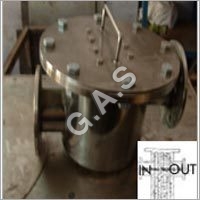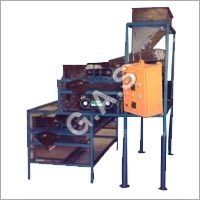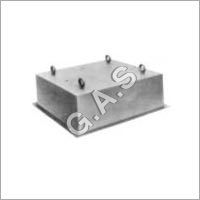Liquid Line Separators
Liquid Line Separators Specification
- Composite
- Stainless Steel Housing; Rare Earth Magnetic Element
- Magnet Grade
- N52 or Equivalent
- Frequency
- 50/60 Hz
- Surface Finish
- Mirror/Gloss Polished
- Power
- Not Required (Magnetic Operation)
- Material
- Stainless Steel (304/316)
- Product Type
- Liquid Line Magnetic Separator
- Magnet Category
- Permanent Magnet
- Shape
- Cylindrical with Flanged Ends
- Size Range
- 1 to 6 (Pipe Diameter)
- Color
- Metallic/Silver
- Usage & Applications
- Inline magnetic separation in food, chemical, pharmaceutical, and dairy industries
- Capacity
- Up to 20,000 LPH or customized
Liquid Line Separators Trade Information
- Minimum Order Quantity
- 1 Piece
- Supply Ability
- 10 Pieces Per Month
- Delivery Time
- 1 Week
About Liquid Line Separators
With our immense domain expertise, we are offering quality assured range of Liquid Line Separators. Designed for liquid and semi-liquid line flow system, these separators employ slip in cage of stainless steel permanent magnet tubes that is used to capture tramp metal particles. Our seasoned technocrats fabricate these separators using premium quality basic components as per set international standards. We offer these Liquid Line Separators in different size, design and other technical specifications at reasonable prices.
Features:
- Easy to clean
- Resettable components
- Robust construction
- Long operational life
Superior Corrosion Resistance
Constructed from premium stainless steel (304/316), these separators are highly resistant to corrosion, making them suitable for aggressive liquids commonly encountered in demanding applications. The mirror/gloss polished finish further aids cleaning and maintains hygienic standards, particularly important for food and pharmaceutical processing environments.
Flexible Installation and Configuration
Supporting both vertical and horizontal installations with flanged or threaded connections, these separators adapt easily to existing or new pipelines. Available for pipe diameters from 1 to 6 inches and customizable for larger requirements, they seamlessly integrate into various liquid processing systems in different industries.
Energy-Free Magnetic Separation
Equipped with rare earth permanent magnets (up to 12,000 Gauss, N52 grade or equivalent), these separators provide high-efficiency contaminant removal without external power. Their reliable operation and robust construction ensure minimal maintenance and long-term performance, benefiting both operational costs and product purity.
FAQs of Liquid Line Separators:
Q: How does a liquid line magnetic separator work in an inline process?
A: Liquid line magnetic separators utilize powerful rare earth permanent magnets encased in a cylindrical stainless steel housing. As liquids flow through the separator, ferrous contaminants are captured and held by the magnetic elements, allowing clean product to exit downstream. This process operates continuously without the need for external power.Q: What industries can benefit from installing these magnetic separators?
A: These separators are ideally suited for the food, beverage, chemical, pharmaceutical, and dairy industries, where ferrous particle removal is essential for process purity, product quality, and equipment protection. Their hygienic design and corrosion-resistance make them safe for strict processing environments.Q: When should I opt for a custom temperature or size configuration?
A: Custom configurations should be considered when your application involves higher temperatures than the standard 80C limit, or if your pipeline requires a diameter outside the standard 1 to 6 inch size range. Custom options are also available for increased flow capacity or unusually aggressive process fluids.Q: Where should these separators be installed in my process line?
A: Liquid line separators should be installed inline at points where liquid or slurry flows need purification, ideally upstream of sensitive equipment or before final product storage. They support both vertical and horizontal orientations, ensuring flexibility for new or retrofit installations.Q: What is the installation process for these separators?
A: Installation is straightforward; simply choose the appropriate flanged or threaded connection compatible with your pipeline. Mount the separator in your desired orientation (vertical or horizontal), and ensure a proper seal for leak-free operation. No electrical connection is required as magnetic separation is passive.Q: What are the primary benefits of using a rare earth magnetic element in these separators?
A: Rare earth magnetic elements (such as N52 or equivalent) provide exceptionally high magnetic strength, enabling efficient capture of even fine ferrous particles. This ensures superior product quality, protects downstream equipment, and reduces maintenance costs associated with contamination.

Price:
- 50
- 100
- 200
- 250
- 500
- 1000+
More Products in Magnetic Equipments Category
Magnetic Roll Separators
Price 300000 INR
Minimum Order Quantity : 1 Piece
Usage & Applications : Separation of fine, dry materials, minerals, pharmaceutical powders
Magnet Category : Other, Permanent Magnet
Shape : Other, Cylindrical Roll
Magnet Type : Other, Neodymium Iron Boron (NdFeB)
Suspended Permanent Magnets
Price 20000 INR
Minimum Order Quantity : 1 Piece
Usage & Applications : Used in mining, quarrying, recycling, cement, and material handling
Magnet Category : Other, Suspended Type
Shape : Other, Rectangular
Magnet Type : Other, Permanent Magnets
Double Drum Magnetic Separator
Price 200000 INR
Minimum Order Quantity : 1 Piece
Usage & Applications : Iron ore processing, glass, recycling, chemical, mineral beneficiation
Magnet Category : Other, Double Drum
Shape : Other, Cylindrical drum
Magnet Type : Other, Permanent Magnet / Electromagnetic available
Bullet Magnet
Minimum Order Quantity : 1 Piece
Usage & Applications : Installed in pipelines and gravity chutes to trap ferrous impurities from powders, granules, grains, and liquids
Magnet Category : Other, Separation Magnet
Shape : Other, Cylindrical/Bullet Shape
Magnet Type : Other, Permanent Magnet

 Send Inquiry
Send Inquiry






 Send Inquiry
Send Inquiry Send SMS
Send SMS